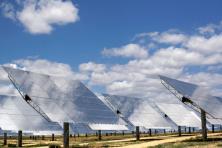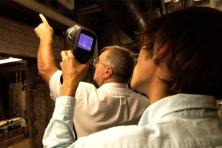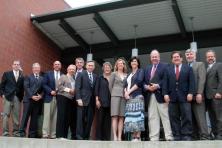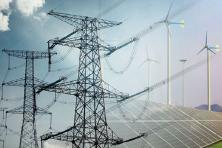How does a city go about becoming carbon neutral?
Four Puget Sound expert-practitioners debated this hot topic on a panel called Carbon Neutrality: Dream or Reality? that the New Energy Cities team facilitated. The discussion was part of a six-month campaign that started in April to celebrate the 50th anniversary of the 1962 Seattle World's Fair and ask what the next 50 years of life in Seattle might look like.
Panelists included Pete Erickson, Senior Staff Scientist, Climate and Energy Program for Stockholm Environment Institute (SEI); Vincent Martinez, Director of Research for Architecture 2030 and board member of Seattle 2030 District; Matt Kuharic, Senior Climate Change Specialist in King County’s Department of Natural Resources and Parks; and David Fujimoto, Manager of the City of Issaquah’s Office of Sustainability.
Communities attempting to address, if not neutralize, carbon emissions start first with a commitment to significant carbon reduction, such as the goal that King County and the City of Issaquah have adopted: reducing community-wide greenhouse gas emissions 80 percent below their 2007 level by 2050. Communities must then inventory their carbon emissions which, as Kuharic and Erickson noted, can be contentious and complicated.
King County asked SEI, a 20-year-old international research institute that bridges science and policy, to perform a “geographic plus” inventory for King County, accounting for energy consumed within the County, even if the energy is produced outside of the region. The inventory, which is included in the King County Comprehensive Plan, determined that the County accounted for a total of 23.4 million tons in 2008, an overall increase of five percent between 2003 and 2008, but a slight decrease in per person emissions.
Also working with SEI, the City of Seattle commissioned a study attempting to determine the scale of actions required in order to achieve ambitious reductions of carbon emissions. Published in May 2011,Getting to Zero: A Pathway to a Carbon Neutral Seattle comprehensively details how Seattle might attain carbon neutrality by 2050. To achieve the high bar of carbon neutrality, the city will have to sequester carbon, generate additional low-carbon electricity, buy verified offsets, and make dramatic shifts in consumption behavior.
Vincent Martinez, Research Director for Architecture 2030, a nonprofit organization whose mission is to rapidly transform the U.S. and global Building Sector from the major contributor of greenhouse gas emissions to become a central part of the solution to the climate change, addressed the common misimpression that Seattle is already carbon-neutral because hydropower comprises a large portion of electricity generation, noting that not all heating is provided by electricity.
"Half of energy used in buildings downtown over the course of a year comes from natural gas," Martinez pointed out. With buildings accounting for 77 percent of all electricity use in the United States—most of which is sourced from coal—the built environment is a crucial place to focus carbon mitigation efforts.
Seattle 2030 District, one of the first high-performance building districts in the United States, was inspired by a study done for Chicago’s downtown loop. The District builds on a Seattle ordinance (CB 116731) passed in 2010 requiring public energy disclosure from the major downtown buildings and aims to dramatically reduce environmental impacts of building construction and operations through education and cooperation across all sectors of the built environment in order to attain the goals laid out by the Architecture 2030 Challenge for Planning.
Seattle 2030 District is private-sector led, with property managers at the helm, but also draws on crucial public sector support, including data from King County assessments. Criteria for participation include a willingness to share data and track collective progress over time. Earlier this year Honest Buildings, a Facebook-like website for building energy consumption, went live with a Downtown Seattle page.
Sustainability Director David Fujimoto described how the City of Issaquah is trying to attain its ambitious carbon reduction targets, while dealing with significant growth projections. Partnering with the New Energy Cities to develop a carbon wedge analysis and a Sustainable Energy Strategy, the City is finding that bold innovations like its zHome project will need to become more the norm than the exception.
Some scientists perceive the idea of carbon neutrality for an entity or a particular geographic region to be missing the point, considering that carbon emissions know no geographic borders. From New Energy Cities' point of view, the frame of carbon neutrality is a way to communicate the audacity of what is needed to reduce greenhouse gas emissions to safe levels and to set ambitious goals.
As SEI's Pete Erickson observed, without reinventing our current fossil fuel economy, we are on a global emissions path to raise average temperature by 5 degrees Celsius. That means losing coral reefs, ice sheets, and ecosystems that we rely on for a “safe operating space for humanity.” If we don’t make deep cuts, our future becomes a “bad dream.”
Just as the 1962 World's Fair put Seattle on the map, several Puget Sound organizations and individuals are pioneering the carbon-reducing strategies for buildings and transportation systems today that we must attempt to deploy if we have a hope of attaining the scale of reduction our climate challenge demands.
To see the presentations and listen to the panel discussion, go here.



